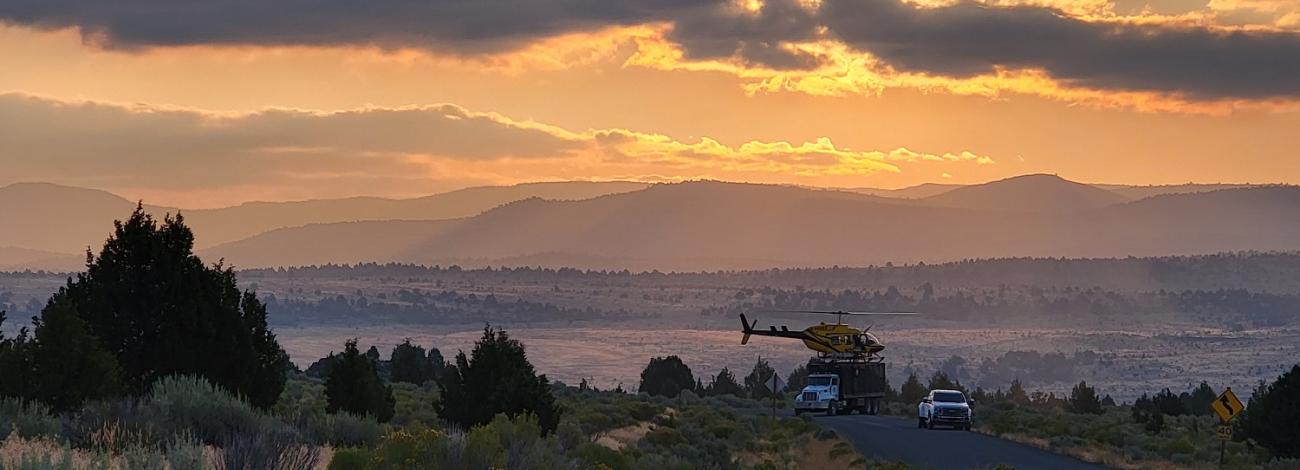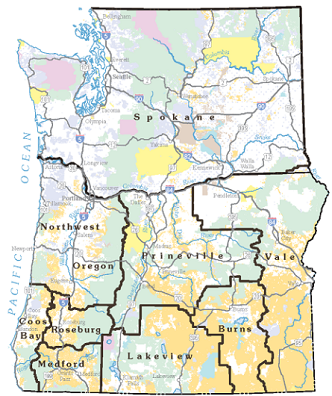
OR/WA Weeds and Invasives Program
Invasive Plants Management
One of the BLM's highest priorities is to promote ecosystem health and one of the greatest obstacles to achieving this goal is the rapid expansion of weeds across public lands. These invasive plants can dominate and often cause permanent damage to natural plant communities. If not eradicated or controlled, weeds will continue to jeopardize the health of the public lands and to constrain the myriad activities that occur on public lands.
Why worry about Noxious Weeds and Invasive Plants?
Non-native plants are plants that have been brought to a place either intentionally or unintentionally by people. Many non-native plants have the potential to rapidly expand unassisted and have negative impacts on these places, such as:
- destroy wildlife habitat
- reduce opportunities for hunting, fishing, camping and other recreational activities
- displace many Threatened and Endangered Species
- reduce plant and animal diversity due to monocultures of a single species
- disrupt waterfowl and neo-tropical migratory bird flight patterns and nesting habitats
- cost millions of dollars in treatment and loss of productivity to private land owners
Integrated Pest Management
The BLM follows the Department of the Interior’s Integrated Pest Management Policy in their efforts to manage invasive species. Integrated Pest Management (IPM) is a science-based decision-making process that combines tools and strategies to identify and manage pests. IPM is “a sustainable approach to managing pests by combining biological, cultural, physical, and chemical tools in a way that minimizes economic, health, and environmental risks.”
IPM provides economic, health, and environmental benefits. IPM practitioners use knowledge of pest and host biology in combination with biological and environmental monitoring to respond to pest problems with management tactics designed to:
- prevent unacceptable levels of pest damage;
- minimize the risk to people, property, infrastructure, natural resources, and the environment; and
- reduce the evolution of pest resistance to pesticides and other pest management practices.
Prevention
The BLM works with state, federal, and local partners to reduce the spread of invasive species, with an emphasis on early detection of and rapid response to new invasions to reduce the need for larger, more expensive treatments later.
The Pacific Northwest has 16.1 million acres of public lands that unfold into a rich tapestry of diverse landscapes, starting where the mighty Columbia River crosses into northeastern Washington from Canada and ending at the lush headwaters of the Chetco River near California. Within that landscape, you’ll find 11 designated BLM Districts. Each has their own challenges with invasive species, ranging from Medusahead in arid eastern Oregon to Scotch broom on northwest Washington’s San Juan Islands.
Use the drop-down menu below to find District-specific noxious weed and invasive plant projects, treatments, proposals and other management efforts:
- Burns
Treatment Area Maps
Fall 2025
- 2025 Fall Treatments Announced
- Aerial Projects 2025 Overview
- Emigrant Creek Unit
- Mud Creek Unit
- Neals Hill Unit
- Otis East FB Unit
- Sagehen Unit
- Silvies River A Unit
- Silvies River B Unit
- Skull Creek A Unit
- Solomon Unit
- Telephone Unit
October 2024
August/September 2024
- Medusahead aerial treatments planned for August - October, 2024
- Notice to hunters / public land users
- Vicinity Map with Hunt Units
- Buck Mountain, Riverside Unit (Malheur River Hunt Unit)
- Cow Creek North and South Units (Malheur River Hunt Unit)
- East Sagehen Unit (Silvies Hunt Unit)
- Krumbo Ridge Unit (Steens Mountain Hunt Unit)
- Moon Hill Ruby Loop Unit (Steens Mountain Hunt Unit)
- Pine Creek North Unit (Malheur River Hunt Unit)
- Rock and Pine Creek Unit (Malheur River Hunt Unit)
- Serrano Point Stonehouse Unit (Steens Mountain Hunt Unit)
- Smyth-Kiger Deep Ruins Unit (Steens Mountain Hunt Unit)
- State Field Unit (Malheur River Hunt Unit
- Coos Bay
District-specific noxious weed and invasive plant projects, treatments, proposals and other management efforts
- Lakeview
BLM to combat invasive grasses with aerial herbicide treatments
Areas treated in Lake County:
- Road 157 Fire (2024) – East Lava Field Wilderness Study Area
- Bowman Well Fire (2024) –10 miles northwest of Christmas Valley
- Tucker Hill Fire (2024) –13 miles southeast of Paisley, west of OR-31
- Warner Peak Fire (2024) – Units south of Hart Mountain National Antelope Refuge near Wool and May Lakes (in partnership with U.S. Fish and Wildlife Service)
- Picture Rock Pass – Between Silver Lake and Summer Lake, east of OR-31
- North Warners – Between OR-140 and Plush Cutoff Road, west of the Fish Creek Rim Wilderness Study Area, including one unit south of Honey Creek
- Clover Flat –7 miles west of Valley Falls
Areas treated in Klamath County:
- Windy Ridge –5 miles southeast of Dairy
- Lorella –2 miles north of Lorella
- Lower Midway and Horsecamp Rim – less than 10 miles southeast of Gerber Reservoir
- Medford
District-specific noxious weed and invasive plant projects, treatments, proposals and other management efforts
- Northwest Oregon
District-specific noxious weed and invasive plant projects, treatments, proposals and other management efforts
- Prineville
District-specific noxious weed and invasive plant projects, treatments, proposals and other management efforts
- Roseburg
District-specific noxious weed and invasive plant projects, treatments, proposals and other management efforts
- Spokane
District-specific noxious weed and invasive plant projects, treatments, proposals and other management efforts
- Vale
District-specific noxious weed and invasive plant projects, treatments, proposals and other management efforts
Help Slow the Spread of Noxious Weeds and Invasive Plants!
An individual can do many things to help prevent the introduction and spread of noxious weeds. Become familiar with the noxious weeds in your area and treat them on your own property to prevent their spread. Wash your vehicles and equipment before venturing into new areas to prevent tracking weeds into non-infested areas. Report weeds on BLM administered lands to the local BLM weed coordinator.

